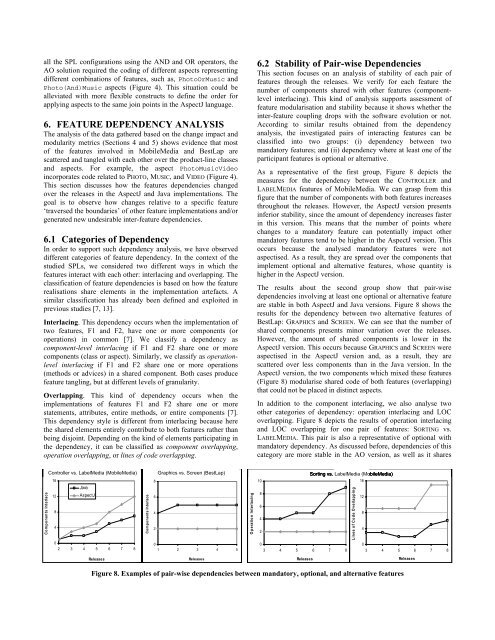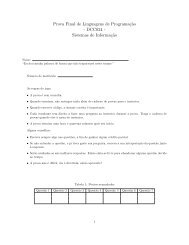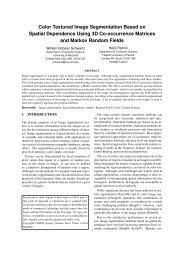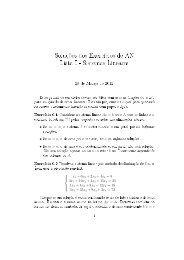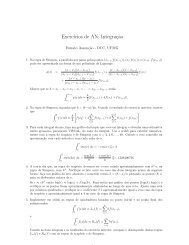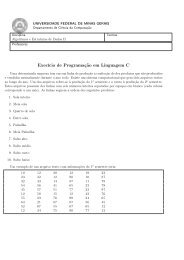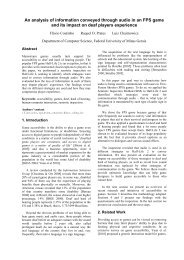Evolving Software Product Lines with Aspects: An Empirical ... - UFMG
Evolving Software Product Lines with Aspects: An Empirical ... - UFMG
Evolving Software Product Lines with Aspects: An Empirical ... - UFMG
Create successful ePaper yourself
Turn your PDF publications into a flip-book with our unique Google optimized e-Paper software.
all the SPL configurations using the AND and OR operators, the<br />
AO solution required the coding of different aspects representing<br />
different combinations of features, such as, PhotoOrMusic and<br />
Photo(<strong>An</strong>d)Music aspects (Figure 4). This situation could be<br />
alleviated <strong>with</strong> more flexible constructs to define the order for<br />
applying aspects to the same join points in the AspectJ language.<br />
6. FEATURE DEPENDENCY ANALYSIS<br />
The analysis of the data gathered based on the change impact and<br />
modularity metrics (Sections 4 and 5) shows evidence that most<br />
of the features involved in MobileMedia and BestLap are<br />
scattered and tangled <strong>with</strong> each other over the product-line classes<br />
and aspects. For example, the aspect PhotoMusicVideo<br />
incorporates code related to PHOTO, MUSIC, and VIDEO (Figure 4).<br />
This section discusses how the features dependencies changed<br />
over the releases in the AspectJ and Java implementations. The<br />
goal is to observe how changes relative to a specific feature<br />
‘traversed the boundaries’ of other feature implementations and/or<br />
generated new undesirable inter-feature dependencies.<br />
6.1 Categories of Dependency<br />
In order to support such dependency analysis, we have observed<br />
different categories of feature dependency. In the context of the<br />
studied SPLs, we considered two different ways in which the<br />
features interact <strong>with</strong> each other: interlacing and overlapping. The<br />
classification of feature dependencies is based on how the feature<br />
realisations share elements in the implementation artefacts. A<br />
similar classification has already been defined and exploited in<br />
previous studies [7, 13].<br />
Interlacing. This dependency occurs when the implementation of<br />
two features, F1 and F2, have one or more components (or<br />
operations) in common [7]. We classify a dependency as<br />
component-level interlacing if F1 and F2 share one or more<br />
components (class or aspect). Similarly, we classify as operationlevel<br />
interlacing if F1 and F2 share one or more operations<br />
(methods or advices) in a shared component. Both cases produce<br />
feature tangling, but at different levels of granularity.<br />
Overlapping. This kind of dependency occurs when the<br />
implementations of features F1 and F2 share one or more<br />
statements, attributes, entire methods, or entire components [7].<br />
This dependency style is different from interlacing because here<br />
the shared elements entirely contribute to both features rather than<br />
being disjoint. Depending on the kind of elements participating in<br />
the dependency, it can be classified as component overlapping,<br />
operation overlapping, or lines of code overlapping.<br />
Components Interlace<br />
Controller vs. LabelMedia (MobileMedia) Graphics vs. Screen (BestLap)<br />
16<br />
12<br />
8<br />
4<br />
Java<br />
AspectJ<br />
0<br />
2 3 4 5 6 7 8<br />
Releases<br />
Components Interlace<br />
8<br />
6<br />
4<br />
2<br />
0<br />
1 2 3<br />
Re lease s<br />
4 5<br />
Operation Interlacing<br />
6.2 Stability of Pair-wise Dependencies<br />
This section focuses on an analysis of stability of each pair of<br />
features through the releases. We verify for each feature the<br />
number of components shared <strong>with</strong> other features (componentlevel<br />
interlacing). This kind of analysis supports assessment of<br />
feature modularisation and stability because it shows whether the<br />
inter-feature coupling drops <strong>with</strong> the software evolution or not.<br />
According to similar results obtained from the dependency<br />
analysis, the investigated pairs of interacting features can be<br />
classified into two groups: (i) dependency between two<br />
mandatory features; and (ii) dependency where at least one of the<br />
participant features is optional or alternative.<br />
As a representative of the first group, Figure 8 depicts the<br />
measures for the dependency between the CONTROLLER and<br />
LABELMEDIA features of MobileMedia. We can grasp from this<br />
figure that the number of components <strong>with</strong> both features increases<br />
throughout the releases. However, the AspectJ version presents<br />
inferior stability, since the amount of dependency increases faster<br />
in this version. This means that the number of points where<br />
changes to a mandatory feature can potentially impact other<br />
mandatory features tend to be higher in the AspectJ version. This<br />
occurs because the analysed mandatory features were not<br />
aspectised. As a result, they are spread over the components that<br />
implement optional and alternative features, whose quantity is<br />
higher in the AspectJ version.<br />
The results about the second group show that pair-wise<br />
dependencies involving at least one optional or alternative feature<br />
are stable in both AspectJ and Java versions. Figure 8 shows the<br />
results for the dependency between two alternative features of<br />
BestLap: GRAPHICS and SCREEN. We can see that the number of<br />
shared components presents minor variation over the releases.<br />
However, the amount of shared components is lower in the<br />
AspectJ version. This occurs because GRAPHICS and SCREEN were<br />
aspectised in the AspectJ version and, as a result, they are<br />
scattered over less components than in the Java version. In the<br />
AspectJ version, the two components which mixed these features<br />
(Figure 8) modularise shared code of both features (overlapping)<br />
that could not be placed in distinct aspects.<br />
In addition to the component interlacing, we also analyse two<br />
other categories of dependency: operation interlacing and LOC<br />
overlapping. Figure 8 depicts the results of operation interlacing<br />
and LOC overlapping for one pair of features: SORTING vs.<br />
LABELMEDIA. This pair is also a representative of optional <strong>with</strong><br />
mandatory dependency. As discussed before, dependencies of this<br />
category are more stable in the AO version, as well as it shares<br />
10<br />
8<br />
6<br />
4<br />
2<br />
0<br />
3 4 5 6 7 8<br />
Releases<br />
Sorting vs. LabelMedia (MobileMedia)<br />
<strong>Lines</strong> of Code Overlapping<br />
16<br />
12<br />
8<br />
4<br />
0<br />
3 4 5 6 7 8<br />
Releas es<br />
Figure 8. Examples of pair-wise dependencies between mandatory, optional, and alternative features


